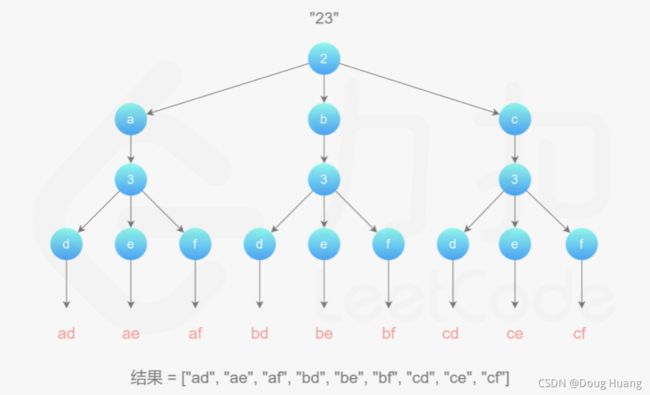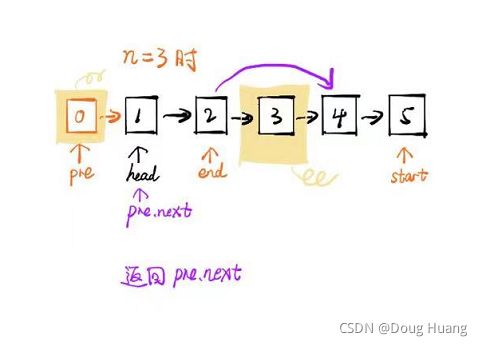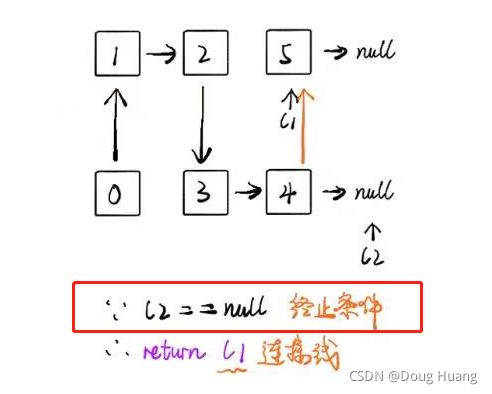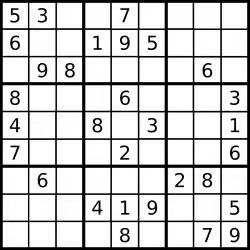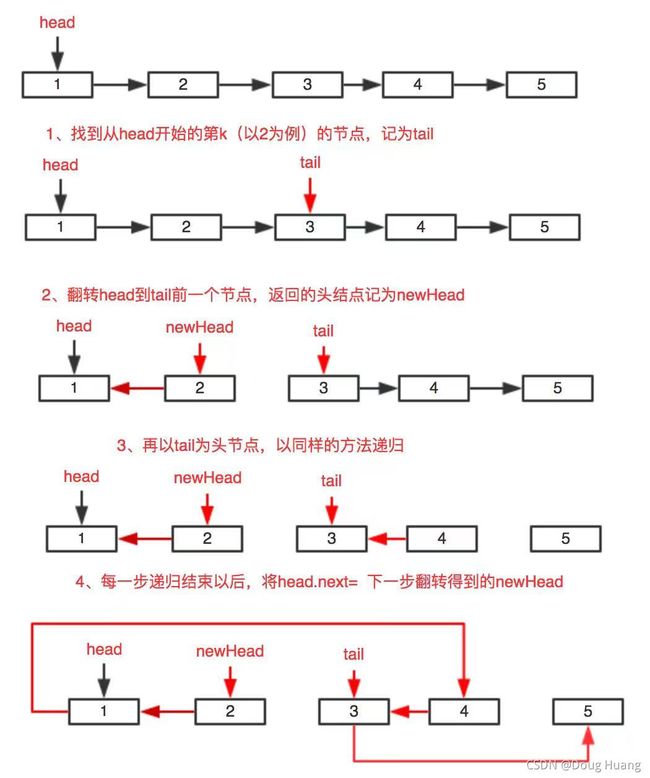算法笔记——每日一题(完结)
算法笔记 From Now To My Death
-
- 前言
- 初级算法
-
-
- 1、两数之和
- 7、整数反转
- 9、回文数
- 14、最长公共前缀
- 27、移除元素【拷贝复制】
- 28、实现strStr()【双指针】
- 35、搜索插入位置
-
- 中级算法
-
-
- 2、两数相加【预先指针】
- 3、无重复字符的最长子串【滑动窗口】
- 5、最长回文子串【动态规划】
- 6、Z字形变换
- 8、字符串转整数【模拟C/C++中的atoi函数】
- 11、盛水最多的容器【双层for-->双指针优化】
- 15、三数之和【排序+双指针】
- 16、最接近的三数之和【排序+双指针】
- 17、电话号码的数字组合【回溯递归】
- 18、四数之和【排序+双指针】
- 19、删除链表的倒数第n个节点【巧妙的双指针】
- 20、有效的括号【栈的使用】
- 21、合并两个有序链表【递归】***
- 22、括号生成【深度优先遍历 + 回溯递归】
- 24、两两交换链表中的节点【回溯递归】
- 29、两数相除【移位运算】
- 31、下一个排列
- 33、搜索旋转排序数组
- 34、在排序数组中找出目标元素第一个和最后一个出现的位置。
- 36、有效数独
- 38、外观数列【递归】
- 300、最长递增子序列【动态规划】
-
- 高级算法
-
-
- 4、寻找两个正序数组的中位数【归并排序、二分查找】
- 23、合并K个升序链表【合并2个有序链表(方法二)升级版】
- 25、翻转K个一组的链表
- 30、串联所有单词的子串【滑动窗口】
- 32、最长的有效括号【栈】
- 37、解数独【回溯递归】
-
此篇以完结:为了抓住面试重点:转向剑指Offer每日一题系列。Click me forward to new article
前言
以前当兵的时候,每次搞30公里强行军都很累。于是我会在50斤的背囊上写着:行百里者半九十——>靠着这句话,即使腿抽筋着,我都能坚持自己完成下来。
现在,我同样用这句话来激励自己,天下没有难学的技术,只有半途而废的人。不要求我一定能成为技术大牛(毕竟这需要一定的天赋和机遇)
旦求无愧于自己。平凡而不平庸即可。
比昨天的自己更好一点,比明天的自己更差一点
初级算法
1、两数之和
给定一个数组nums,和一个整数目标值target。从数组中找出两个元素,他们的和 = target。
返回对应两个元素的数组下标。
public int[] twoSum(int[] nums, int target){
Map<Integer,Integer> map = new HashMap<>();
for(int i = 0; i < nums.length(); i ++){
// 利用 【Map集合的containsKey API】
// 逆向思维: target = key + nums[i]
// ===> map.key = target - nums[i]时 返回结果!
if(map.containsKey(target - nums[i])){
return new int[]{map.get(target - nums[i]), i};
}
}
map.put(nums[i],i);
}
return null;
如果用双层for循环固然简单,但是时间复杂度为O(n^2)
解题思路:
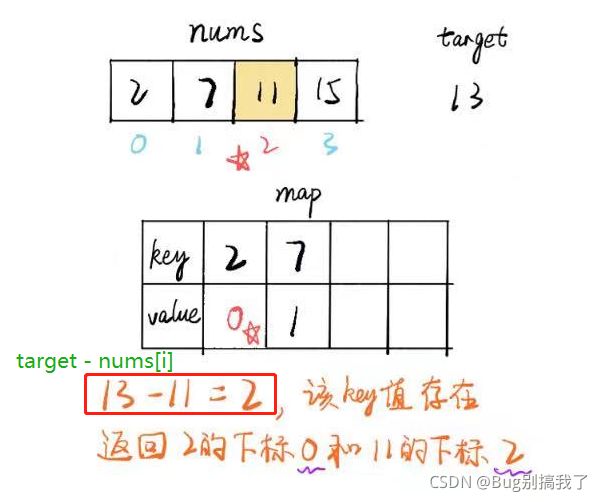
7、整数反转
给你一个32位的有符号整数x,返回将x中的数字反转后端结果。
如果反转后的整数超过32位的有符号整数的范围[-2^31, 2^31 - 1]——> 返回 0
public int reverse(int x) {
32位整数范围是:-2147483648 ~ 2147483647
为快速判断:只要将反转后的值,与最大值的最后两个数:十位 / 个位 进行比较即可
1、当反转后的值 大于十位之前的值时:无论它的各位数是几,都是越界的:214748365* 与 2147483647
2、当反转后的值 等于十位之前的值时:判断其个位 是否>最大值的个位:214748364* 与 2147483647
int res = 0; // 初始 0
while(x!=0) {
每次摘下当前 x 的个位
int tmp = x%10;
当摘下->放入 执行到214748364共9位时,即可进行判断
(如果全部反转完再判断,则会抛出异常)
因此,反转到最后2个(十位)时,如果大于了最大值的十位,则没必要比较个位了、
如果反转到十位时,发现和最大值的十位及其之前的数都相等。则需要再反转一次:比较个位
//判断是否 大于 最大32位整数
if (res>214748364 || (res==214748364 && tmp>7)) {
return 0;
}
//判断是否 小于 最小32位整数
if (res<-214748364 || (res==-214748364 && tmp<-8)) {
return 0;
}
// res:当前这一步while反转后的值
res = res*10 + tmp; 将当前 x 的个位,放入反转后的值的个位中
// 由于 原值 x 的末尾数字已经被取走:放入res中了。
// 因此 原值x 就少扣除末尾的那一位。
x /= 10;
}
return res;
}
9、回文数
给你一个整数x,如果x是一个回文整数,返回true。否则返回false。
eg:123不是回文。121是回文
直接StringBuilder.reverse => 但是这样要额外创建对象、并且反转整个字符串来比较
实际上:只要反转x的前半段,然后与后半段比较即可、如11222211; 反转1122—>2211 == 后半段!
private static boolean test(int x){
if (x <= 0 || ( x % 10 == 0 && x != 0)){
return false;
}
int revertedNum = 0;
// 通过 % 和 /的方式,达到string字符串remove的效果
// eg: 1122332211 ==> 每次从末尾摘除一位,赋给revertedNum后,x就要扣除一位
// 最后 x = 11223 == revertedNum = 11223 退出循环!
while (x > revertedNum){
// 反转后的数 = 上次反转的数 * 10 + 本次 x 的末尾摘下的个位
revertedNum = revertedNum * 10 + x % 10;
// 本次x被摘下了个位,于是就x剩下 x / 10;
// 这样只需要摘除x的一半长度时,即可判断是否为回文数
x = x / 10;
}
// 如果x是奇数:那么退出循环的结果会是 x=1122 revertedNum=11223
// 所以x == revertedNum / 10 时也为true;
return x == revertedNum || x == revertedNum / 10;
}
14、最长公共前缀
寻找一个字符串数组中的最长公共前缀,不存在则返回""
private static String test(String[] arr){
if (arr.length == 0){
return "";
}else if (arr.length == 1){
return arr[0];
}
String commonString = "";
String first = arr[0];
int flag = 0;
for (int i = 0; i < first.length(); i++) {
for (int j = 1; j < arr.length; j++) {
if (!arr[j].startsWith(first.substring(0, i))){
flag = 1;
break;
}
}
if (flag == 1){
break;
}
commonString = first.substring(0, i);
}
return commonString;
}
27、移除元素【拷贝复制】
给你一个整数数组、和一个目标值val。移除该数组中所有值等于val的元素。返回移除后的长度。
要求:原地修改数组、不使用额外的空间。
public static void main(String[] args) {
int[] nums = {1,2,3,4,5,6};
System.out.println(removeElement(nums,5));
}
private static int removeElement(int[] nums, int val){
int result = 0;
for (int i = 0; i < nums.length; i++) {
//在原数组上:发现与val相同的元素,则跳过
// 与val不同的元素,则放入数组前面,保存下来。并且长度++
if (nums[i] != val){
nums[result] = nums[i];
result++;
}
}
return result;
}
28、实现strStr()【双指针】
给你两个字符串haystack和needle,请你再haystack字符串中找出needle字符串出现的第一个位置
如果不存在,则返回 -1; 当needle字符串为空时,应该返回0;
这与C语言定义的strStr()函数以及Java定义的indexOf()函数相当
双指针在数组遍历中非常非常地常见
private static int indexOf(String haystack, String needle){
int result = 0;
if (haystack.equals("") || needle.length() > haystack.length()){
return -1;
}
if (needle.equals("")){
return 0;
}
int left = 0, right = needle.length();
while (right < haystack.length()){
String substring = haystack.substring(left, right);
if (substring.equals(needle)){
return left;
}
left++;
right++;
}
return result;
}
35、搜索插入位置
很简单的一题、没啥可说的。
给你一个无重复元素的升序数组、给你一个target、找出target的插入位置。如果已有target则返回索引
private static int searchInsertPosition(int[] nums, int target){
if (target < nums[0]){
return 0;
}
if (target > nums[nums.length - 1]){
return nums.length;
}
int left = 0, right = nums.length - 1;
int mid = 0;
while (left < right){
mid = (left + right) / 2;
if (nums[mid] == target){
return mid;
}
if (nums[mid] < target){
left = mid + 1;
}else {
right = mid - 1;
}
}
return mid;
}
==============================================================================
中级算法
2、两数相加【预先指针】
给你两个【非空】链表,表示两个非负整数。他们的每位数字都是按照【逆序】的方式存储的,
并且每个节点只能存储【一位】数字。
请你将两个数相加,并以相同形式返回一个表示和的链表。
你可以假设除了数字0之外,这两个数都不会以0开头。
示例:l1 = [2, 4, 3] 、 l2 = [5, 6, 4]、 342 + 465 = 708 、、 return [7, 0, 8]
先看看我的解题思路:代码有点复杂
就是用简单的:每一位与每一位相加,>0则往上一位进1。我这里没有给短的List用0补全。
而LetCode大佬的解法是:把短的这个List用0补全——>构造出 l1长度 == l2,然后进行进位运算
public ListNode addTwoNumbers(ListNode l1,ListNode l2){
// 用于存储最后结果的list链表
LinkedList<Integer> list = new LinkedList<>();
//存储每次要进位的数
int z = 0;
// 如果传进来的l1 > l2 则交换一下位置
if (l1.size() > l2.size()){
return addTwoNumbers(l2,l1);
}
Iterator i1 = l1.iterator();
Iterator i2 = l2.iterator();
// 小的链表驱动大的表
while (i1.hasNext()){
// 取出l1的尾元素
int last1 = l1.removeLast();
// 取出l2的尾元素
int last2 = l2.removeLast();
// 计算两之和
int sum = last1 + last2 + z;
// 求出余数
int y = sum % 10;
// 求出进位的数 18则进位1 即 z = 1
z = sum / 10;
// 余数即可放入return的链表中了
list.add(y);
}
// 当小的链表都取完了之后,直接取大的链表剩余的部分即可。
for (int i = 0; i < l2.size(); i++) {
int last = l2.removeLast();
// 注意也要加上之前余留的进位数 z
int sum = last + z;
int y = sum % 10;
z = sum / 10;
// 把余数加到return的list中
list.add(y);
}
// 最后,如果进位!=0,则说明还没加完,把最后这个进位加到末尾即可。
if (y != 0){
list.add(z);
}
return list;
}
3、无重复字符的最长子串【滑动窗口】
给定一个字符串s,请你找出其中不含有重复字符的【最长子串】的长度
例如:输入s = “pwwkew” 输出3
// 博主的渣渣解题方法: 时间复杂度为O(m)
public int getMaxLengthOfString(String s){
String result = "";
int max = 1;
for (int i = 0; i < s.length(); i++) {
String c = String.valueOf(s.charAt(i));
System.out.println("char[" + i + "] -->" + c);
System.out.println("result --pre-->" + result);
// 判断目前筛选出的无重复字符的字符串result中,是否含有将要比对的这个字符 c
if (result.contains(c)){
System.out.println("此次result为" + result + ",发现重复字符:" + c);
max = Math.max(max,result.length());
System.out.println("目前筛选出的不重复字符串result的最大长度为:" + max);
// 重置之前筛选出的result为当前发现的这个重复字符:继续往后筛选比对
result = c;
System.out.println("重置result! 重置后的result为:" + result);
}else {
System.out.println("当前result中不包含"+ c +",将" + c + "加入result中...");
result = result + c;
System.out.println("result --post-->" + result);
}
System.out.println("------------------------------>");
}
System.out.println("筛选完毕,返回结果------->");
return max;
}
LetCode大佬的【滑动窗口】算法
窗口:内含无重复字符的最长子串。每次找到重复字符,指针滑动到重复字符处!
坚持寻找无重复字符找了好久都没重复!突然发现了一个重复的!前功尽弃!在这里重新开始
private static int getMaxLengthOfString(String s){
int n = s.length(), ans = 0;
// key为字符 value为下标+1
// map中存着目前已经扫描到的字符及其下标
Map<Character, Integer> map = new HashMap<>();
for (int end = 0, start = 0; end < n; end++) {
char alpha = s.charAt(end);
if (map.containsKey(alpha)) {
// 如果map中已经包含的这个字符:即发现了重复字符
// 则将起始指针移至重复字符的下标处
start = Math.max(map.get(alpha), start);
}
// 不包含则将本次的长度置为新的最大长度ans
ans = Math.max(ans, end - start + 1);
// 并将本次扫描过的字符放到map中, 以便下次contains比较
map.put(s.charAt(end), end + 1);
}
return ans;
}
5、最长回文子串【动态规划】
给你一个字符串s,找到s中的最长回文子串:即字符串关于中心对称(左=右)
如:s=“babad” return “bab”; s=“cbbd” return “bb”;
解法:动态规划!为减少重复计算:
每次都需要对内层字符串是否为回文串进行重复判断
将内层字符串是否为回文串缓存起来!这样就不用重复判断了
用一个boolean dp[l][r] (类似Redis,缓存着上一次的回文串) 表示字符串从i -> j是否为回文子串。
要判断i->j为回文子串,dp[l][r]=true===>即要判断它的前一位是否为回文子串dp[l-1][r-1]=true
public String longestPalindrome(String s) {
// 如果s的长度为1、那回文串就是她本身
if (s == null || s.length() < 2) {
return s;
}
int strLen = s.length();
int maxStart = 0; //最长回文串的起点
int maxEnd = 0; //最长回文串的终点
int maxLen = 1; //最长回文串的长度
// 类似redis:缓存着上一轮的最大回文子串
boolean[][] dp = new boolean[strLen][strLen];
// r指针从1开始 -> 末尾
for (int r = 1; r < strLen; r++) {
// l指针从0开始 -> r ==> 这样循环下来就能从左到右把所有可能性都遍历一次
for (int l = 0; l < r; l++) {
// 如果本次l=r,那么就要看看他们的前一位是否也为回文子串
// 1.如果r-l<=2即长度为3的时候,那就不用判断dp=true。直接为true!eg:bab
if (s.charAt(l) == s.charAt(r) && (r - l <= 2 || dp[l + 1][r - 1])) {
// 判断成功!将本次true记录一下
dp[l][r] = true;
// 并且如果本次长度合法、则记录头指针和尾指针、用于返回最后结果
if (r - l + 1 > maxLen) {
maxLen = r - l + 1;
maxStart = l;
maxEnd = r;
}
}
}
}
return s.substring(maxStart, maxEnd + 1);
}
6、Z字形变换
将一个给定字符串s根据给定的行数numRows,从上往下、从左往右进行Z字排序
eg:输入PAYPALISHIRING,numRows=3时。排列为:
之后:将该Z字形排列从左往右逐行读取,产生新的字符串:PAHNAPLSIIGYIR
解答:
何时Z字形字符的方向开始变化!
1、每次在行数 = 0 和 numRows - 1 (即两端处方向发生变换)
2、rowNow = 0 时下一个元素所在行号:为本次行号 + 1,为numRows - 1时:回头:为本次行号 - 1
3、定义一个boolean的flag来标志下一行行号是该 + 1 还是 - 1 ?
用什么数据结构来存储每一行读出的字符?并方便最后结果的拼接?
4、定义一个String类型数组、长度为numRows、数组下标0对应第0行读出的字符、下标1对应第一行

private static String convert(String s, int numRows){
if (numRows == 1){
return s;
}
// 这里按道理是直接取(行数)len = numRows,但要考虑特殊情况。
// 如:s的长度比numRows还小时,直接输出s即可
int len = Math.min(s.length(), numRows);
// 声明一个字符串数组:下标为 0 1 2的分别存储第0 1 2行的字符
// 最后再将这个数组中的字符串依次拼接即可
String rows[] = new String[len];
for (int row = 0; row < len; row++) {
// 先通过for循环把需要的几行数组元素初始化为空串
rows[row] = "";
}
// down为false时,为向右上走(i-1)。true为向下走(i+1)
boolean down = false;
// 定义当前所在行
int rowNow = 0;
// 开始顺序遍历s字符串:
for (int i = 0; i < s.length(); i++) {
// 第0个放第0行中,第1个放第1行...遇到方向变化则回头
rows[rowNow] += s.charAt(i);
// 在当前行数为0;或为numRows - 1:即在两端口时,需要变换方向
if (rowNow == 0 || rowNow == numRows -1){
down = ! down;
}
// 下次循环的行数rowNow是根据转向标志flag来判断是+1还是-1;
rowNow += down ? 1 : -1;
}
// 至此,String数组中每个元素都存着对应下标行读取出的字符
// 因此把他们从0->len拼接起来即可
String result = "";
for (int i = 0; i < len; i++) {
System.out.println("--第" + i + "行数据为:-->" + rows[i]);
result += rows[i];
}
return result;
}
8、字符串转整数【模拟C/C++中的atoi函数】
1、第一步:丢弃读入字符串无用的前导空格:" 1" => 1
2、第二步:检查下一符号是"+“还是”-",并作为结果正负的依据:" -1" => -1
3、第三步、读入下一非数字字符,直到到达下一非数字字符,往后的其余字符部分则会忽略:
" -0011231 asdada" => -11231 ———— “words and 987” => “0”:因为第三步未解析到数字,结果为0
4、 如果超过Integer的最大和最小值,则取最大最小值
关键点:如何判断char字符是否为a-z或0-9?根据ASCII码:int 值 = char(x) - ‘0’
public static int myAtoi(String str) {
int len = str.length();
// str.charAt(i) 方法回去检查下标的合法性,一般先转换成字符数组
char[] charArray = str.toCharArray();
// 1、去除前导空格
int index = 0;
while (index < len && charArray[index] == ' ') {
index++;
}
// 2、如果已经遍历完成(针对极端用例 " ")
if (index == len) {
return 0;
}
// 3、如果出现符号字符,仅第 1 个有效,并记录正负
int sign = 1;
char firstChar = charArray[index];
if (firstChar == '+') {
index++;
} else if (firstChar == '-') {
index++;
sign = -1;
}
// 4、将后续出现的数字字符进行转换
// 不能使用 long 类型,这是题目说的
int res = 0;
while (index < len) {
char currChar = charArray[index];
// 4.1 先判断不合法的情况、通过字符的ACSII码来判断是否是合法数字
if (currChar > '9' || currChar < '0') {
break;
}
// 题目中说:环境只能存储 32 位大小的有符号整数,
// 因此,需要提前判断乘以 10 以后是否越界 (本次char作为个位 + res*10为新的结果)
if (res > Integer.MAX_VALUE / 10 ||
(res == Integer.MAX_VALUE / 10 && (currChar - '0') > Integer.MAX_VALUE % 10)) {
return Integer.MAX_VALUE;
}
if (res < Integer.MIN_VALUE / 10 || (res == Integer.MIN_VALUE / 10 && (currChar - '0') > -(Integer.MIN_VALUE % 10))) {
return Integer.MIN_VALUE;
}
// 4.2 合法的情况下,才考虑转换,每一步都把符号位乘进去
// currChar - '0' 的 ASCII码的结果:正好就是数字的值:56(8) - 48(0) = 8
res = res * 10 + sign * (currChar - '0');
index++;
}
return res;
}
public static void main(String[] args) {
String str = "2147483646";
int res = myAtoi(str);
System.out.println(res);
System.out.println(Integer.MAX_VALUE);
System.out.println(Integer.MIN_VALUE);
}
11、盛水最多的容器【双层for–>双指针优化】
给你一串数字:int[] arr = {1, 8, 6, 2, 5, 4, 8, 3, 7}; 输出最大水容量 = 49
定义水容量为:两数字间的距离 * Math.min(数字1,数字2) ==> 即:较小的数字影响水的高度
1、简单解法: 双层for循环寻找:时间复杂度O(n^2)
2、考虑是否可以优化双层for?因为双层for是暴力解法,时间比较慢?
==>双指针 ==> 用双指针的话! 关键点就化为 ⇒ 每次循环结束:改移动哪个指针?
// 凡是遇到【双层for循环的问题】==>考虑是否可用【双指针优化】
private static int test(int[] arr){
int capacity = 0;
int len = arr.length;
int i = 0, j = len - 1, hi = 0, hj = 0;
// 从左右两边两个指针往中间遍历,时间复杂度O(n)。双层for则是O(n^2)
while (i < j){
hi = arr[i];
hj = arr[j];
capacity = Math.max(capacity, (j - i) * Math.min(hi,hj));
// 这是一个数学规律:由水容量公式 = h * Math.min(hi,hj)
// 因此,只要移动本次较短的那个木板,因为是他限制了我的水容量
// 移动短的木板,尝试去找到比他更长的木板来提升水容量!
// 假设移动的是较长的木板,两种情况:
// 1.长木板找到更长的!但水容量是由短木板限制的,
// Math.min(hi,hj)不变,而水桶宽度缩短 ==>必然造成水容量下降!
// 2.长木板找到比原先更短或一样长的!new Hight <= old Hight
// 而水桶宽度缩短 ==> 水容量也必然下降
===> 因此,这就是我们要找的条件:【每次循环结束:该移动较短的木板】
if (hi > hj){
j --;
}else {
i ++;
}
}
return capacity;
}
15、三数之和【排序+双指针】
给你一个数组nums = [-1,0,1,2,-1,-4]; 找出三数之和 = 0;并且不重复的所有组合
输出:[[-1,-1,2],[-1,0,1]];
关键点:1、将数组进行排序–>因为三数之和=0;要求有负有正,L < R
2、 三个数:固定一个数!剩余两个数使用双指针!
3、左右指针:何时移动左、何时移动右。
public static List<List<Integer>> threeSum(int[] nums) {
List<List<Integer>> ans = new ArrayList();
int len = nums.length;
if(nums == null || len < 3) {
return ans;
}
Arrays.sort(nums); // 排序
for (int i = 0; i < len ; i++) {
if(nums[i] > 0) {
break; // 如果当前数字大于0,则三数之和一定大于0,所以结束循环
}
//每一轮循环定下first第一个数后。
// 就会将它后面的L(i+1) ~ R(len-1)范围内,所有符合条件的组合都筛选出来!
// 假设i=0时。值为 -1。那么所有满足L+R+i(value)=0的组合就已经在本次循环查出来了!
// i=1时,值如果和上一次i(i=0)相同,本次循环i=1 < i=0。L和R的检索范围小于上一次的范围
// 由于上一次已经查出了所有满足条件的组合。因此这一次范围更小的循环必然重复
if(i > 0 && nums[i] == nums[i-1]) {
continue; // 去重
}
int L = i+1;
int R = len-1;
while(L < R){
int sum = nums[i] + nums[L] + nums[R];
if(sum == 0){
// 如果本次满足要求。则添加到结果中
ans.add(Arrays.asList(nums[i],nums[L],nums[R]));
//这里为什么是这样去除L和R的重复值的?
// while(L
// 在第一个数i 相同的情况下。L和R只要有一个数确定了,另一个数也就确定了!
// 也就是说,本次循环i是相同的,只要L和R有一个数重复了,那么结果必然重复!因此L R都需要去重
// 为了下一次计算出的sum不是重复值!要将L指针移动到下一个非重复值处
while (L<R && nums[L] == nums[L+1]) {
L++; // 去重
}
// 为了下一次计算出的sum不是重复值!要将R指针移动到下一个非重复值处
while (L<R && nums[R] == nums[R-1]) {
R--; // 去重
}
L++;
R--;
}
// 本轮总和<0,说明正数要多一些 即L++
else if (sum < 0) {
L++;
// 本轮总和>0,说明正数要少一些 即R--
} else if (sum > 0) {
R--;
}
}
}
return ans;
}
16、最接近的三数之和【排序+双指针】
给的一个数组nums(lenth > 3)和target。找出nums中最接近target的三个数的和
eg:nums = [-1,2,1,-4] target = 1。返回结果: 1
解法:同题:15
public static int threeSum(int[] nums,int target) {
Arrays.sort(nums); // 排序
int distance = Math.abs(target - nums[0] + nums[1] + nums[2]);
int result = 0;
for (int i = 0; i < nums.length ; i++) {
int L = i+1;
int R = nums.length-1;
while(L < R){
int now = nums[i] + nums[L] + nums[R];
if(Math.abs(target - now) < distance){
// 如果本次满足要求
distance = Math.abs(target - now);
result = now;
L++;
R--;
}
// 本轮总和
else if (now < target) {
L++;
// 本轮总和>target,说明正数要少一些 即R--
} else if (now > target) {
R--;
}
}
}
return result;
}
17、电话号码的数字组合【回溯递归】
给定一个数字组合(2-9):输出其所有的字母组合
根节点为2时、对应有a、b、c、三个子节点。三个子节点又都拥有d e f 子子节点
时间复杂度:O(3^m ✖ 4^n)
private static List<String> result = new ArrayList<String>();
private static StringBuilder combination = new StringBuilder();
private static Map<Character, String> phoneMap = new HashMap<Character, String>() {{
put('2', "abc");
put('3', "def");
put('4', "ghi");
put('5', "jkl");
put('6', "mno");
put('7', "pqrs");
put('8', "tuv");
put('9', "wxyz");
}};
public static void main(String[] args) {
System.out.println(letterresult("23"));
}
public static List<String> letterresult(String digits) {
// 排空
if (digits.length() == 0) {
return result;
}
// 回溯:递归调用。
backtrack(digits, 0);
return result;
}
private static void backtrack(String digits, int index) {
// 如果本次已经检索到最底层了!eg:23 length=2 index = 2时,
// 说明是第三层目录了。而总共就两层,所以这次应该回溯
// 即满足回溯条件。则输出这次结果 result.add
if (index == digits.length() && combination != null) {
System.out.println("达到底层,返回结果:" + combination.toString());
result.add(combination.toString());
} else {
char digit = digits.charAt(index); // "23" -> 拿到 2
String letters = phoneMap.get(digit); // 拿到2对应的字母abc
int lettersCount = letters.length(); // abc的长度为3
for (int i = 0; i < lettersCount; i++) { // 以abc为一级目录进行树形搜索
System.out.println("添加前:" + combination.toString());
System.out.println("添加combination:" + letters.charAt(i));
combination.append(letters.charAt(i)); // 把a(本次层级)添加进combination
System.out.println("添加后:" + combination.toString());
// 递归调用时、又会遍历index = 1 即二级目录:"3"
// 对应字母def。将d e f分别与a组合。 combination.append(letters.charAt(i));
// 得出 ad ae af
backtrack(digits, index + 1);
// --> a的分支(共两层)遍历完后,会在第三层时判断满足条件,回溯 result.add(combination.toString());
// 从而:本分支backtrack方法递归结束了,此时执行下一步: deleteCharAt只删除本层(index)。保留父层级
System.out.println("清空前:" + combination.toString());
combination.deleteCharAt(index);
System.out.println("清空后:" + combination.toString());
}
}
}
18、四数之和【排序+双指针】
给你n个整数组成的数组nums、和一个目标值target!找出满足条件的四元数组!
条件:1、a b c d各不相同。2、nums[a] + nums[b] + nums[c] + nums[d] == target
eg:输入nums = [1, 0, -1, 0, -2, 2]。target = 0
输出:[[-2, ,1, 1, 2], [-2, 0, 0, 2], [-1, 0, 0, 1]]
参照第16题
public static void main(String[] args) {
int[] arr = {1,0,-1,0,-2,2};
test(arr,0).forEach(System.out::println);
}
private static List<List<Integer>> test(int[] nums, int target){
List<List<Integer>> result = new ArrayList<>();
int len = nums.length;
if (nums == null || len <= 3){
return null;
}
Arrays.sort(nums);
for (int i = 0; i < len - 3; i++) {
if(nums[i] > 0) {
break;
}
if (i > 0 && nums[i] == nums[i-1]){
continue;
}
int LL = i + 1;
for (; LL < len - 2; LL++) {
if (LL > 0 && nums[LL] == nums[LL-1]){
continue;
}
int L = LL + 1;
int R = len - 1;
while (L < R){
int sum = nums[i] + nums[LL] + nums[L] + nums[R];
if (sum == target){
result.add(Arrays.asList(nums[i],nums[LL],nums[L],nums[R]));
}
if (nums[L] == nums[L + 1]){
L++;
}
if (nums[R] == nums[R - 1]){
R--;
}
//注意!移动双指针中L或R指针 的条件是什么?
if (target > sum){
L++;
}else {
R--;
}
}
}
}
return result;
}
19、删除链表的倒数第n个节点【巧妙的双指针】
删除链表的倒数第n个节点(注意:我们不知道链表的长度、
链表不像数组集合ArrayList那样,可以通过索引直接删除,链表可不行)
思路:L和R指针初始时,为一个new出来的空节点。指向链表头节点。
1、先移动R指针。移动n次。而后同时移动L和R,直至R到达链表末尾:R.next == null;
——>这样一来:保证了L指针和R指针之间间隔了n个节点。那么当R为尾节点时:L.next就是要删除的节点
private static ListNode removeNthFromEnd(ListNode head, int n){
if (head == null){
return null;
}
ListNode pointer = new ListNode(0);
pointer.next = head;
//初始化左右两个节点。使其指向头结点
ListNode L = pointer, R = pointer;
while (n != 0){
//单独移动R指针,移动n次。
R = R.next;
n--;
}
此时L.next就是以R开始的倒数第n个节点
// 将R和L同时移动,直至R为尾节点
while (R.next != null){
R = R.next;
L = L.next;
}
//此时:L所指节点L.next即为倒数第n位。删除L指向的节点
L.next = L.next.next;
//不能返回pointer,要返回pointer.next。
//head头结点可能会当成第n个删除。所以不能直接返回head(虽然pointer.next指的就是head)
return pointer.next;
}
static class ListNode {
int val;
ListNode next; // 下一个节点
ListNode(int x) { val = x; } //赋值
}
20、有效的括号【栈的使用】
给定一个只包含(){}[]的字符串s。判断字符串是否有效:
左右相同类型的括号要闭合。【必须以正确的顺序闭合】
正确顺序闭合?——> 内层的需要先闭合完、外层才能闭合!
——>很容易想到使用数据结构:栈!
先进后出。先出现的左符号(即外层的)、要放在栈底、等后出现的左符号(内层)闭合完!
再轮到栈底(外层的符号)弹出,然后判断是否闭合!——即:按顺序闭合
public static boolean test(String s){
// 排除特殊情况
if (s.length() == 0 || s.length() % 2 != 0){
System.out.println("s的长度为0、或长度不为偶数:返回false");
return false;
}
// 用哈希表存储字符的映射规则
Map<Character,Character> map = new HashMap();
map.put('[',']');
map.put('{','}');
map.put('(',')');
// 定义一个栈
Stack<Character> stack = new Stack();
// 遍历字符串
for (int i = 0; i < s.length(); i++) {
char c = s.charAt(i);
1、如果碰到右闭合符!则不压入、pop出栈顶、判断是否闭合
// 相当于数据结构算法中学过的:碰到运算符+-*/()等优先级高的字符,则出栈。
if (c == ']' || c == '}' || c == ')'){
// 如果第一个字符就为右闭合符:则此时stack中还未push。为null。返回false
if(stack == null){
return false;
}
// 如果pop出的左闭合符和对应的右闭合符不匹配。则返回false
if (map.get(stack.pop()) != c){
return false;
}
}else {
2、否则:是左闭合符:入栈
stack.push(c);
}
}
return true;
}
21、合并两个有序链表【递归】***
将两个有序链表(非递减链表)合并为一个升序链表
【方法一】:递归:在原链表上合并。不新增链表。
递归要素:终止条件:l1或 l2为空时。
递归的理解:不用一步步去想中间的递归步骤。会绕晕的!
我们只看递归的最后一步:即递归出口的地方。本题中的倒数第二轮递归判断出:
(Node:4.val < Node:5.val):因此走:head2.next = mergeList(head1, head2.next);
head2:节点4、head2.next:节点4的next指针:即【连接线】
将head2.next(即null)作为最后一轮递归方法mergeList中的参数2传进去(ListNode head2)
因为head2.next 为 null。即最后一轮递归中。判断出head2 == null。
此处:递归结束!return head1;。而head1即为节点5。return节点5到上一轮递归方法的结果中————>①
于是上一轮递归方法head2.next = mergeList(head1, head2.next);就化为:【head2.next = 节点5】
即图中红色箭头的那根线:节点4指向节点5。
由于找到了出口。代码head2.next = mergeList(head1, head2.next); 执行完毕。
就执行下一行:return head2; ———————————————————————————————>②
而head2不就是本次倒数第二轮递归的节点4吗?最后一轮递归找到了出口:return节点5(①)。
并组成了合并后的有序链表:4 -> 5。节点4即为排好序的链表的头结点!
因此这里return head2(②); 即返回了排好序的链表的头结点:4
关键在于:从递归的最后一步(出口处)开始分析。只有最后一步找到出口return后,每一轮的递归方法才会执行完毕得到返回值,从而每轮的递归方法才能结束。如果找不到出口。就会一直递归下去。
public static ListNode mergeList(ListNode head1, ListNode head2){
if (head1 == null){
return head2;
}
if (head2 == null){
return head1;
}
if (head1.val < head2.val){
// head1.next即为head1的连接线!
// 因为head1是本轮中,较小的值。因此他就作为本轮的头结点。
// 即:【本轮较小的节点head1作为头结点:指向已合并好的链表的头】
// 一直递归下去:mergeList递归出口就是l1或l2为null时。
// mergeList即合并好的有序链表。每次递归都让本次较小的节点与排好序的链表头相连!
head1.next = mergeList(head1.next, head2);
return head1;
}else {
head2.next = mergeList(head1, head2.next);
return head2;
}
}
static class ListNode{
private int val;
private ListNode next;
public ListNode(){}
public ListNode(int value){
this.val = value;
}
}
方法二:不用递归。用新的一个链表来存储结果(也就是第23题:合并K个升序链表所使用的方法)
public static ListNode mergeList(ListNode head1, ListNode head2){
if (head1 == null || head2 == null){
return head1 == null ? head2 : head1;
}
// 新链表的 哑元节点
ListNode head = new ListNode(0);
// 指针
ListNode pointer = head, first = head1, second = head2;
while (first != null && second != null){
if (first.val < second.val){
pointer.next = first;
first = first.next;
}else {
pointer.next = second;
second = second.next;
}
pointer = pointer.next;
}
pointer.next = (first == null ? second : first);
return head.next;
}
22、括号生成【深度优先遍历 + 回溯递归】
这题有点类似17题电话号码的递归实现
根节点为 ( 时。子节点可能为 ( 或 )、依次递归寻找合法的子节点所构成的树
设n为()括号的数量。根据给定的n。返回出所有合法的括号组合
private static List<String> result = new ArrayList<>();
public static void main(String[] args) {
test(2).forEach(System.out::println);
}
public static List<String> test(int n){
// 排除特殊情况
if (n == 0){
return null;
}
//调用递归方法
dfs("", 0, 0, n);
return result;
}
// left right分别表示已使用的“(” 和 “)”的数量。 current表示本递归分支中括号的组成结果
private static void dfs(String current, int left, int right, int n){
// 递归出口:left和right的使用数都达到n,则结束
if (left == n && right == n){
result.add(current);
return;
}
// 如果当前left
// 即:将本二叉树的分支剪掉
if (left < right){
return;
}
// 如果 ( 还有可用数、则加入一个 (
if (left < n){
dfs(current + "(", left + 1, right, n);
}
if (right < n){
dfs(current + ")", left, right + 1, n);
}
}
24、两两交换链表中的节点【回溯递归】
public static void main(String[] args) {
ListNode list1 = new ListNode(1);
list1.next = new ListNode(2);
list1.next.next = new ListNode(3);
list1.next.next.next = new ListNode(4);
StringBuilder sb = new StringBuilder();
sb.append("head");
ListNode listNode = exchangeTwoNode(list1);
// 输出结果
while (listNode != null) {
sb.append( "->" + listNode.val);
listNode = listNode.next;
}
System.out.println(sb);
}
【交换方法】
private static ListNode exchangeTwoNode(ListNode head){
// 当前无节点,或只有一个节点时:无法交换,直接原样返回
if (head == null || head.next == null){
return head;
}
// head的next就是交换后的新head(先把旧头结点摘下来)
ListNode newHead = head.next;
// 下一轮要交换的链表是newHead.next ==>
// 即、把:head.next.next(旧的尾节点所指向的那个节点:即为下一轮要交换的链表的链表头)
// 作为下一轮要交换的链表头,传入递归方法。
// 让head指向 -> 交换后的链表。
head.next = exchangeTwoNode(newHead.next);
// 新的头结点的 指针 -> 指向尾节点(旧头)
newHead.next = head;
// 返回新头结点
return newHead;
}
static class ListNode{
private int val;
private ListNode next;
public ListNode(int value){
this.val = value;
}
}
29、两数相除【移位运算】
给定两个整数,被除数dividend和除数divisor。将两数相除,要求不使用乘法、除法和mod运算符。
返回被除数dividend除以除数divisor得到的商。
整数触发的结果应当截取其(truncate)小数部分。例如truncate(8.345) = 8
这题LeetCode用了移位运算来实现➗2。以下是我的解法,移位运算不想了解她了
private static int truncate(int dividend, int divisor){
long result = 0;
int last = 0;
// 默认为正数
boolean flag = true;
if ((dividend < 0 && divisor > 0) || (dividend > 0 && divisor < 0)){
flag = false;
}
dividend = Math.abs(dividend);
divisor = Math.abs(divisor);
while (last + divisor< dividend) {
last += divisor;
result++;
}
if (result >= Integer.MAX_VALUE){
if (flag){
return Integer.MAX_VALUE;
}else {
return Integer.MIN_VALUE;
}
}
return flag ? (int)result : (int)-result;
}
31、下一个排列
实现获取【下一个排列】的函数、算法需要将给定的数字序列重新排列成字典序中下一个更大的排列。
——>即:组合出下一个更大的整数
如果不存在下一个更大的排列,则将数组重新排列成最小的排列(即升序排列)
必须【原地】修改,允许使用额外的常数空间
eg:输入nums = [1, ,2, 3] 输出:[1, 3, 2]
关键在于:对【下一个排列】的理解
public static void main(String[] args) {
int[] param = {1,2,3,8,5,7,6,4};
int[] result = nextSorted(param);
for (int i : result) {
System.out.print(i + " ");
}
}
public static int[] nextSorted(int[] nums){
// 特殊校验
if (nums.length <= 1){
return null;
}
// minIndex记录着需要交换的值往右的数组中:比它大的最小的数
//eg:图中需要交换的值是:5。5往右的数组中,6和7都比他大、但是6是比他大的最小的数
// 因此6所在的索引就存入minIndex、将来6就会和5进行交换
int minIndex = -1;
// 是否找到满足条件的值
boolean flag = false;
// 从后往前遍历:nums[i]为当前需要比较的值
for (int i = nums.length - 2; i > 0; i--) {
// 遍历i 往右的数组
for (int j = i + 1; j < nums.length - 1; j++) {
// 如果找到了比 nums[i]大的数、
if (nums[j] > nums[i]){
// 比较本轮数组中找出的比他大的数 是否 < 上一轮找出的比他大的数?
// 是:把本轮找出的数的索引存入、 否:保持原样
// 这里需要判断minIndex==-1? 即:是否是第一次找到比nums[i]大的数
minIndex = Math.min(nums[j], minIndex == -1 ? nums[j] : nums[minIndex]) == nums[j] ? j : minIndex;
// 条件已满足!
flag = true;
}
}
// 如果条件满足,交换值
if (flag){
// 交换值
int temp = nums[i];
nums[i] = nums[minIndex];
nums[minIndex] = temp;
// 为本轮i往右的数组进行排序-->
// 注意 这里sort(a,fromIndex,toIndex):这个to需要实际的toIndex + 1
// 因为源码实际调用时 toIndex-1 了:DualPivotQuicksort.sort(a, fromIndex, toIndex - 1, null, 0, 0);
Arrays.sort(nums,i + 1, nums.length);
// return
return nums;
}
}
// 如果找不到下一个排列、则将数组重新以升序排序
Arrays.sort(nums);
return null;
}
33、搜索旋转排序数组
一个元素互不相同的整数递增的数组nums、在传递给函数前会在随机一个下标k处进行旋转、
然后再传递给函数、请你在传递后的数组中、找出给定的目标值target。
解题关键点:有序数组的查询、必然是用二分查找、那么这个数组被旋转过、仍然可用二分查找吗?
当然是可以的!思路在于:每次确定二分查找的mid时、左边的数组和右边的数组总有一个是有序数组
通过左边或右边的有序数组和target的比较、就能确定下次二分查找该往哪边进行
eg:nums = {0,1,2,4,5,6,7}。在下标k=3处旋转后,nums = {4,5,6,7,0,1,2}
private static int searchSpinSortedArray(int[] nums, int target){
int len = nums.length;
if (len == 0){
return -1;
}
int left = 0, right = len - 1;
while (left <= right){
int mid = (right - left) / 2;
if (nums[mid] == target){
return mid;
}
// 接下来判断下一轮二分查找该往mid的左边找、还是右边找
//如果mid的左边是有序数组
if (nums[0] <= nums[mid]){
// 并且target的值在mid左边的有序数组内
if (nums[0] <= target && target < nums[mid]){
right = mid - 1;
}else {
left = mid + 1;
}
}else
// 如果0>mid的值:说明mid的右边才是有序数组
{
// 并且target值在mid右边的有序数组范围内
if (nums[mid] < target && target <= nums[left - 1]){
left = mid + 1;
}else {
right = mid - 1;
}
}
}
return -1;
}
34、在排序数组中找出目标元素第一个和最后一个出现的位置。
没啥好说的、一个简单的二分查找法。
public static void main(String[] args) {
int[] param = {5,7,7,8,8,10};
for (int i : getFirstAndLast(param, 8)) {
System.out.print(i + " ");
}
}
private static int[] getFirstAndLast(int[] nums, int target){
int[] result = {-1,-1};
int len = nums.length;
if (len == 0 || target < nums[0]){
return result;
}
int left = 0, right = len -1;
for (int i = 0; i < len; i++) {
int mid = (right + left) / 2;
if (target == nums[mid]){
int temp = mid;
result[0] = mid;
result[1] = mid;
while ((mid - 1) >= 0 && nums[mid] == nums[mid - 1]){
result[0] = mid - 1;
mid--;
}
while ((temp + 1) < len && nums[temp] == nums[temp + 1]){
result[1] = temp + 1;
mid++;
}
break;
}
if (target <= nums[mid]){
right = mid - 1;
}
if (target > nums[mid]){
left = mid + 1;
}
}
return result;
}
36、有效数独
判断输入的9x9数独是否有效:(没有数字的格子用" . "表示)
1、同一行1-9数字只能出现一次
2、同一列1-9数字只能出现一次
3、每个3X3方格中、1-9数字只能出现一次
类似第6题:Z字形变换。这种图形化的参数传递进来、都需要用某种数据结构来表示他。
这里用的是矩阵来表示
private static boolean judgeEffective(char[][] board) {
//每一行1-9数字是否出现
int[][] row = new int[9][10];
//每一列1-9数字是否出现
int[][] col = new int[9][10];
//每一个方格中1-9数字是否出现
int[][] box = new int[9][10];
for (int i = 0; i < 9; i++) {
for (int j = 0; j < 9; j++) {
int current = board[i][j] == '.' ? -1 : board[i][j] - '0';
// 如果当前格子没有数字、则继续下一次循环。
if (current == -1) {
continue;
}
//判断在当前行是否出现过
if (row[i][current] != 0) {
return false;
}
//判断在当前列是否出现过
if (col[j][current] != 0) {
return false;
}
//判断在当前方格是否出现过
if (box[i + 1 + j / 3][current] != 0) {
return false;
}
// 都没出现过、则本轮有效、出现次数+1
row[i][current] = 1;
col[j][current] = 1;
box[i + 1 + j / 3][current] = 1;
}
}
return true;
}
38、外观数列【递归】
外观数列的第一项:n=1时、值是1
第二项:11 ——> 一个1
第三项:21 ——> 两个1
第四项:1211 ——> 一个2一个1
第五项:111221 ——> 一个1一个2两个1
每一项都是对前一项的描述:可以看成一种由递归公式组成的数列。
显然、这一题用递归解决
public static void main(String[] args) {
System.out.println(countAndSay(5));
}
private static String countAndSay(int n){
// 递归出口:n=1时、值为1
if (n == 1){
return "1";
}
//递归拿到n的前一项的值:对前一项的描述就是本项的结果、本项的结果又返回给下一项
String lastResult = countAndSay(n - 1);
int first = 0;
List<String> temp = new ArrayList<>();
// 将前一项按相同连续字符划分成多个字符串组
for (int i = 0; i < lastResult.length(); i++) {
if (i + 1 == lastResult.length()){
temp.add(lastResult.substring(first));
break;
}
if (lastResult.charAt(first) == lastResult.charAt(i + 1)){
continue;
}
temp.add(lastResult.substring(first, i + 1));
first = i + 1;
}
String result = "";
//对划分出的字符串组进行描述:几个几? length()个charAt(0)
for (int i = 0; i < temp.size(); i++) {
result += temp.get(i).length() + String.valueOf(temp.get(i).charAt(0));
}
return result;
}
300、最长递增子序列【动态规划】
给你一个不重复的数组、求该数组的最长递增子序列的长度
递增子序列:严格按照递增的顺序排列
方法一(动态规划):
public static void main(String[] args) {
int[] param = new int[8];
param[0] = 2;
param[1] = 5;
param[2] = 7;
param[3] = 8;
param[4] = 6;
param[5] = 9;
param[6] = 10;
param[7] = 18;
System.out.println(lengthOfLIS(param));
}
public static int lengthOfLIS(int[] nums) {
if(nums.length == 0) return 0;
// dp[i]存的是nums数组中、以索引i为结尾的最长递增子序列的 长度!
// 此dp[i]存的不是当前找到的最长递增子序列、不是严格递增的。因此不能二分
int[] dp = new int[nums.length];
int res = 0;
Arrays.fill(dp, 1);
for(int i = 0; i < nums.length; i++) {
// 与i之前的各个值nums[j]进行比较
for(int j = 0; j < i; j++) {
// 如果nums[i]比值nums[j]大、
// 则下标为i时的最长子序列长度、就可以在索引为j时的长度基础上 + 1
if(nums[j] < nums[i]) dp[i] = Math.max(dp[i], dp[j] + 1);
}
res = Math.max(res, dp[i]);
}
return res;
}
方法二(动态规划 + 二分查找)(时间复杂度 O(n·logn)):
public static int lengthOfLIS(int[] nums){
// 此dp存储:当前找到的最长递增子序列
int[] dp = new int[nums.length];
dp[0] = nums[0];
int x = 0;
for (int i = 1; i < nums.length; i++) {
// 如果num比dp[x]小(如果num比之前的递增子序列的最大值更小)
if (nums[i] < dp[x]){
// 如果nums[i]比dp[x]小 且比dp[x]里其他的数大(满足递增条件)、才能覆盖
// 由于dp[x]存的是严格递增的子序列、因此可以用二分法
int left = 0;
while (left < x){
int m = (x + left) / 2;
//若 中间数仍小于num:下一次在右半区间比较
if (dp[m] < nums[i]){
left = m + 1;
}else {
// 否则、说明不能覆盖(覆盖后就不符合严格递增了)
left = x;
}
}
// 如果flag=true 覆盖。
if (left < x){
dp[x] = nums[i];
}
}else {
dp[++x] = nums[i];
}
}
return x+1;
}
==============================================================================
高级算法
4、寻找两个正序数组的中位数【归并排序、二分查找】
此题目的:并不是遍历所有!而是找到某个数 (中位数)
解法一:由于是两个正序数组中寻找:考虑是否使用【归并】化为一个数组?
解法二:寻找【顺序数组中】的某个数?考虑使用二分查找减少查找次数(每次排除一半!)
给定两个大小分别为m和n的正序数组nums1和nums2。请你找出并返回这两个正序数组的中位数、
示例:nums1 = [1,3] nums2 = [2] 输出:2
示例:nums1 = [1,2] nums2 = [3,4] 输出:2.5
我的结论是找规律:nums1求和 = sum1 nums2求和 = sum2 中位数:sum1 + sum2 / 2
显然,我的这种做法虽然能做出来。但是没有用到所谓的归并排序算法,时间O(m + n)。
public static double getMidNum(int[] nums1, int[] nums2) {
int m = nums1.length;
int n = nums2.length;
double sum1, sum2;
int midm = m / 2, midn = n / 2;
if (m == 0) {
sum1 = 0;
} else if (m == 1) {
sum1 = nums1[0];
} else {
if (m % 2 == 0) {
sum1 = (nums1[midm - 1] + nums1[midm]) / 2;
} else {
sum1 = nums1[midm] / 2;
}
}
if (n == 0) {
sum2 = 0;
} else if (n == 1) {
sum2 = nums2[0];
} else {
if (n % 2 == 0) {
sum2 = (nums2[midn - 1] + nums2[midn]) / 2;
} else {
sum2 = nums2[midn] / 2;
}
}
if (m == 0) {
return sum2;
} else if (n == 0) {
return sum1;
} else {
return (sum1 + sum2) / 2;
}
}
来看看【归并排序】算法的解题步骤:时间O(m + n) 空间O(m + n)
int[] nums;
int m = nums1.length;
int n = nums2.length;
nums = new int[m + n];
// 如果nums1为空,则可以直接返回nums2的中位数
if (m == 0) {
if (n % 2 == 0) {
return (nums2[n / 2 - 1] + nums2[n / 2]) / 2.0;
} else {
return nums2[n / 2];
}
}
// 如果nums2为空,则可以直接返回nums1的中位数
if (n == 0) {
if (m % 2 == 0) {
return (nums1[m / 2 - 1] + nums1[m / 2]) / 2.0;
} else {
return nums1[m / 2];
}
}
// 当两个数组都不为空时,通过while循环合并两个数组
int count = 0;
int i = 0, j = 0;
while (count != (m + n)) {
// 如果nums1的指针走完了,则把nums2剩余的数全部加进来
if (i == m) {
while (j != n) {
nums[count++] = nums2[j++];
}
break;
}
// 如果nums2的指针走完了,则把nums1剩余的数全部加进来
if (j == n) {
while (i != m) {
nums[count++] = nums1[i++];
}
break;
}
// 把目前两个数组的i j指针对应的值中,较小的值放入归并后的数组中!
if (nums1[i] < nums2[j]) {
nums[count++] = nums1[i++];
} else {
nums[count++] = nums2[j++];
}
}
// 最后输出 合并后的数组的 中位数
if (count % 2 == 0) {
return (nums[count / 2 - 1] + nums[count / 2]) / 2.0;
} else {
return nums[count / 2];
}
【二分查找】 时间复杂度达到了极致!:O(log(m+n)) 空间复杂度O(1)
根据中位数的定义:【m+n为奇数】时:中位数为两个数组中【第(m+n)/2 + 1个】元素。
【m+n为偶数】时,中位数为两个数组中【第(m+n)/2个】元素 he 【第(m+n)/2 + 1个】元素的平均值
因此—> 题目转换为:寻找两个有序数组中:第k小的数:与m+n的奇偶性相关
public double findMedianSortedArrays(int[] nums1, int[] nums2) {
int n = nums1.length;
int m = nums2.length;
// 如果n+m是偶数,则中位数为第left和right的平均值
int left = (n + m + 1) / 2;
int right = (n + m + 2) / 2;
//将偶数和奇数的情况合并,如果是奇数,会求两次同样的 k 。
return (getKth(nums1, 0, n - 1, nums2, 0, m - 1, left) + getKth(nums1, 0, n - 1, nums2, 0, m - 1, right)) * 0.5;
}
private int getKth(int[] nums1, int start1, int end1, int[] nums2, int start2, int end2, int k) {
// eg: 6 = 5 - 0 + 1;
int len1 = end1 - start1 + 1;
int len2 = end2 - start2 + 1;
//让 len1 的长度小于 len2,这样就能保证如果有数组空了,一定是 len1 ———调整参数顺序
if (len1 > len2) return getKth(nums2, start2, end2, nums1, start1, end1, k);
if (len1 == 0) return nums2[start2 + k - 1];
//出口:当k被化为求的是第1小的数,就可以返回了!
if (k == 1) return Math.min(nums1[start1], nums2[start2]);
// 为防止索引越界:
//如果k/2比数组长度还大,那最多只能取数组长度那么长
// i j 为本次要排除掉的第x个数对应的数组下标
int i = start1 + Math.min(len1, k / 2) - 1;
int j = start2 + Math.min(len2, k / 2) - 1;
// 由于是有序递增数组,所以可以直接排除较小的
if (nums1[i] > nums2[j]) {
return getKth(nums1, start1, end1, nums2, j + 1, end2, k - (j - start2 + 1));
}
else {
return getKth(nums1, i + 1, end1, nums2, start2, end2, k - (i - start1 + 1));
}
}
23、合并K个升序链表【合并2个有序链表(方法二)升级版】
给你一个【链表数组】,每个链表都是升序排序。请你将所有链表合并为一个升序链表,并返回。
eg:lists = [[1,4,5], [1,3,4], [2,6]]。输出:[1,1,2,3,4,4,5,6]
合并K个升序链表——>就是合并2个有序链表(第21题)的升级版
21题用得递归。但这里没有用递归哈。
private static ListNode result = null;
public static void main(String[] args) {
ListNode list1 = new ListNode(1);
list1.next = new ListNode(4);
list1.next.next = new ListNode(5);
ListNode list2 = new ListNode(1);
list2.next = new ListNode(3);
list2.next.next = new ListNode(4);
ListNode list3 = new ListNode(2);
list3.next = new ListNode(6);
ListNode[] parm = {list1,list2,list3};
// 参数组装完毕
StringBuilder sb = new StringBuilder();
sb.append("head");
ListNode listNode = mergeKListNode(parm);
// 输出结果
while (listNode != null) {
sb.append( "->" + listNode.val);
listNode = listNode.next;
}
System.out.println(sb);
}
private static ListNode mergeKListNode(ListNode[] lists){
// 特判
if (lists.length == 0){
return null;
}
int k = lists.length;
// 每次取链表数组的两个链表元素来合并为一个新的链表。
// 合并后的结果链表。又作为参数和下一个链表元素合并
for (int i = 0; i < k; i++) {
// head.next为2个链表合并后的第一个节点
// 赋给result。即:result = head.next; 即result为新链表的头结点。
// 即:result就代表着新的链表
result = mergeTwoListNode(result ,lists[i]);
}
return result;
}
private static ListNode mergeTwoListNode(ListNode list1, ListNode list2){
if (list1 == null || list2 == null){
return list1 == null ? list2 : list1;
}
// 因为要构造一个新的链表。首先要先创建一个哑元节点head。指向该链表的第一个节点。
ListNode head = new ListNode(0);
// 声明一个指针——>使得head.next永远指向这个链表的头结点。
//(复制一个head节点作为指针:这是必要的!如果直接拿head当指针去移动。则最后返回时,head就会在尾巴,找不到链表头了)
ListNode pointer = head, first = list1, second = list2;
// 当本轮要比较的节点:list1和List2都不为null时。把小的值加入结果
while (first != null && second != null){
if (first.val < second.val){
// 小的节点添加进结果
pointer.next = first;
// 指针后移
first = first.next;
}else {
pointer.next = second;
second = second.next;
}
pointer = pointer.next;
}
// 当其中某个链表被拼接完了,则另一个链表直接接上即可
pointer.next = (first != null ? first : second);
// head.next为2个链表合并后的首节点(代表该链表)。而head是new出来的一个dummy节点
return head.next;
}
static class ListNode{
private int val;
private ListNode next;
public ListNode(int value){
this.val = value;
}
}
25、翻转K个一组的链表
给你一个链表:以K个节点为一组,对其进行反转。并返回反转后的链表。
如果节点数不足K,则保持原样
反转链表图解
关键步骤:
1、设一个dummy节点:作为
2、用临时变量暂存下一次要反转的链表头:即 next = head.next;
3、执行反转操作:head.next = pre;
public static void main(String[] args) {
ListNode list1 = new ListNode(1);
list1.next = new ListNode(2);
list1.next.next = new ListNode(3);
list1.next.next.next = new ListNode(4);
list1.next.next.next.next = new ListNode(5);
StringBuilder sb = new StringBuilder();
sb.append("head");
ListNode listNode = reverseKGroup(list1, 3);
// 输出结果
while (listNode != null) {
sb.append( "->" + listNode.val);
listNode = listNode.next;
}
System.out.println(sb);
}
public static ListNode reverseKGroup(ListNode head, int k) {
if (head == null || head.next == null) {
return head;
}
// tail节点就是下一轮要翻转的链表的头结点。
ListNode tail = head;
for (int i = 0; i < k; i++) {
//剩余数量小于k的话,则不需要反转。
if (tail == null) {
return head;
}
tail = tail.next;
}
// 反转前 k 个元素
ListNode newHead = reverse(head, tail);
// 本轮翻转结束:递归:让本组的旧头head指向下一组的新头newHead
//reverseKGroup(tail, k);返回的是:newHead。
// 即:让head(旧头/新尾)指向newHead
head.next = reverseKGroup(tail, k);
return newHead;
}
/*
左闭右开区间
*/
private static ListNode reverse(ListNode head, ListNode tail) {
// 前一节点
ListNode newHead = null;
ListNode next = null;
while (head != tail) {
// 先用temp变量暂存head.next节点(摘下 head的next指针)
// 拿到头结点的下一个节点:next节点
next = head.next;
【关键步骤】
// 翻转:让head的指针指向newHead (第一轮时newHead=null)
head.next = newHead;
// 将本轮head赋给newHead(本轮的head就是新的newHead)
newHead = head;
// 将head指针后移一位(head = head.next 当前next设为新的head)
head = next;
}
return newHead;
}
static class ListNode{
private int val;
private ListNode next;
public ListNode(int value){
this.val = value;
}
}
30、串联所有单词的子串【滑动窗口】
给定一个字符串s,和一些【长度相同】的单词words。
找出s中恰好可以由words中所有单词串联组成的子串的起始位置。
串联成的子串中间不能有其他字符。【不需要考虑单词的串联顺序】
为什么没想出来?:
1、审题:单词的长度是相同的! 即第一个单词的长度就是后面所有单词的长度。因此单词长度可以作为步长
2、【突破点】:考虑到单词串联顺序的问题、如何解决不同串联顺序下形成不同的子串?
用HashMap集合存储每个单词的个数。用temp临时map存储已经消耗了的单词个数
3、以单词组的总长度来截取子串、以单词的长度len为步长、构建一个滑动窗口、比较子串是否符合条件
public static void main(String[] args) {
String[] words = {"bar","foo","the"};
System.out.println(findSubstring("barfoofoobarthefoobarman", words));
}
public static List<Integer> findSubstring(String s, String[] words){
// allWords存储每个单词的个数
HashMap<String, Integer> allWords = Maps.newHashMap();
for (String word : words) {
allWords.put(word,allWords.getOrDefault(word, 0) + 1);
}
// wordNums:单词个数 len:单词长度(步长)
int wordNums = words.length, len = words[0].length();
outer:for (int i = 0; i < s.length() - wordNums * len + 1; i += len) {
// 临时map、存放当前滑动窗口内已经用的单词及所用次数
HashMap<String, Integer> temp = Maps.newHashMap();
// 存储本轮结果集
List<Integer> result = new ArrayList<>();
// 本轮滑动窗口中的字符串
String window = s.substring(i, i + wordNums * len);
// 对该窗口内的字符串进行比较
for (int j = 0; j < window.length() - 1; j += len) {
// 取出第一个单词
String word = window.substring(j, j + len);
// allWords中包含这个单词,并且temp中还有可用次数
if (allWords.containsKey(word) && temp.getOrDefault(word,0) < allWords.get(word)){
// 使用次数+1
temp.put(word, temp.getOrDefault(word,0) + 1);
// 单词下标加入结果集
result.add(i + j);
}else {
//如果不包含单词、或没有可用次数了。则跳出内层循环、执行下一轮外层循环
continue outer;
}
}
// 如果结果集.size == 单词数。则说明找到结果了
if (result.size() == wordNums){
return result;
}
}
return null;
}
32、最长的有效括号【栈】
给你一个只包含( )的字符串、找出最长有效且连续的子串,返回其长度
需要找出子串、能联想到需要记录有效字符的索引(记录有效子串的最左索引,和最右索引)
和20题类似,这里也用栈的数据结构。区别是这里的栈中存的是有效符号的下标!
==用到了一个新的API。 stack.peek();——>返回:栈顶元素 ==
maxLen = 最后一个有效 ‘)’ 的索引 - 最前一个有效 ‘(’ 的索引
【始终保持栈底元素为最后一个没有被匹配到的右括号的下标】
private static int maxEffectiveStr(String s){
if (s.length() == 0){
return 0;
}
int maxLen = 0;
// 定义一个栈
Deque<Integer> stack = new LinkedList<>();
// 为了解决特殊情况:s = “()”或“(())”等括号完全匹配时:
// stack.peek() == null 、计算不出答案
stack.push(-1);
// 遍历字符串
for (int i = 0; i < s.length(); i++) {
char c = s.charAt(i);
if (c == '('){
stack.push(i);
}else {
stack.pop();
// 【始终保持栈底元素为最后一个没有被匹配到的右括号的下标】
// 这样就能保证 s = "()))()()"这种)个数> (的情况也能算出答案
// i - stack.peek() = 7 - 3 = 4 ——> )>(个数时:
// 栈中只有一个元素:即最后一个没有匹配的 ) 的 下标
if (stack.isEmpty()){
stack.push(i);
}else {
maxLen = Math.max(maxLen, i - stack.peek());
}
}
}
return maxLen;
}
37、解数独【回溯递归】
36题升级版、这题需要我们解出来。
回溯:相当于撤回的意思、应用于多道选择题、且每个选择题有多个答案可选时、
先假设先选答案A、然后按答案A这条分支递归走下去、如果发现是错的、则撤回到上一轮。
上一轮还是错的、就撤回到上上轮
思路:已经想到了:假设碰到第一个空白格时、可供选择的数字有3 7 9、那么这个空白格该填入哪个呢?
解答:不妨先填入3、然后再往下一个空白格继续填入、如果下个空白格没有数字可以填入(冲突了)
那么就回到上一层(如果回到上一层时发现还是冲突、则回到上上层)、
更改填入的数字为7、如果下一轮还是冲突、就再改为填入9——>因为数独肯定有解、所有总能找到一个出口
// 用一个List 记录每个空白格的行i和列j
private static List<int[]> spaces = new ArrayList<>();
// row col box第一维是 行/列/3X3格号
// 第二维长度设为10、是为了能存9这个数字: 长度是指从下标0开始的长度
// 对应行中已出现的数字
private static int[][] row = new int[9][10];
// 对应列中已出现的数字
private static int[][] col = new int[9][10];
// 对应3x3方格中已出现的数字
private static int[][] box = new int[9][10];
// 用作方法出口(终止for循环)
private static boolean valid = false;
public static void main(String[] args) {
char[][] board = new char[9][9];
char[] param = {'5','3','.', '.','7','.', '.','.','.',
'6','.','.', '1','9','5', '.','.','.',
'.','9','8', '.','.','.', '.','6','.',
'8','.','.', '.','6','.', '.','.','3',
'4','.','.', '8','.','3', '.','.','1',
'7','.','.', '.','2','.', '.','.','6',
'.','6','.', '.','.','.', '2','8','.',
'.','.','.', '4','1','9', '.','.','5',
'.','.','.', '.','8','.', '.','7','9'};
int x = 0;
for (int i = 0; i < 9; i++) {
for (int j = 0; j < 9; j++) {
board[i][j] = param[x];
x++;
}
}
solution4Sudoku(board);
for (int i = 0; i < 9; i++) {
StringBuilder sb = new StringBuilder();
for (int j = 0; j < 9; j++) {
char c = board[i][j];
sb.append(c + " ");
}
System.out.println(sb);
}
}
private static void solution4Sudoku(char[][] board) {
for (int i = 0; i < 9; i++) {
for (int j = 0; j < 9; j++) {
if (board[i][j] == '.') {
spaces.add(new int[]{i,j});
}else {
int target = board[i][j] - '0';
row[i][target] = col[j][target] = box[(i/3)*3 + j/3][target] = 1;
}
}
}
dfs(board, 0);
}
private static void dfs(char[][] board, int pos){
// 【递归出口】:空白格数已经被匹配完了
if (spaces.size() == pos){
// 设置valid=true——>找到出口了
valid = true;
// return:本次方法执行结束、即返回到上一次递归调用dfs处、
// 然后进行下一轮for循环、判断 !valid不成立、跳出循环、上次递归dfs方法执行完毕、
// 继续跳回上一轮、跳到最顶上时、最顶一轮也因valid=true跳出for循环而执行完毕
return;
}
int[] ints = spaces.get(pos);
int i = ints[0], j = ints[1];
for (int num = 1; num < 10 && !valid; num++){
// row col box中记录着对应行列中、已经出现过的数字
// eg:行列格 中、都未出现的数字有 3 7 9、那么我们先假定当前空白格填入的数字是3、
// 如果填入3后、递归到的后面的某个空白格也需要填入3(无数字可选、冲突了)
// 那就要回溯到本轮、清空本轮选择的数字3、然后假定本轮空白格填入7、再次尝试!
// 判断这个数字是否在行列格中出现过。
if (row[i][num] == 0 && col[j][num] == 0 && box[(i/3)*3 + j/3][num] == 0){
// 如果找到了行列格中都未出现的数字(假设找到3 7 9、我们选择填入3试试看能不能走到递归出口)、
// 则在对应行 列 格中、记录该数字已经被使用。
row[i][num] = col[j][num] = box[(i/3)*3 + j/3][num] = 1;
// 将该数字的字符放入数独中
board[i][j] = (char)(num + '0');
// 递归开始为下一个空白格寻找合法数字
// 如果本轮num分配正确(所有空白格都能找到匹配的数字)、那么会在出口处return
dfs(board, pos + 1);
// 如果按本轮递归层中选出num分给本轮空白格是错误的:不能使所有空白格都分配到合法的数字
// 即:(没有走到出口处return)(说明本轮为该空白格假定的数字num会导致其他空白格无数字可选择)
// 因此:回溯到这一层(即:递归dfs方法时没有return回去、而是执行完了、则会走到下面的代码)
// 设置本轮选择出的数字3为原始状态(未使用)
row[i][num] = col[j][num] = box[(i/3)*3 + j/3][num] = 0;
// 走下一轮for循环、选择数字7再试试
}
}
}


